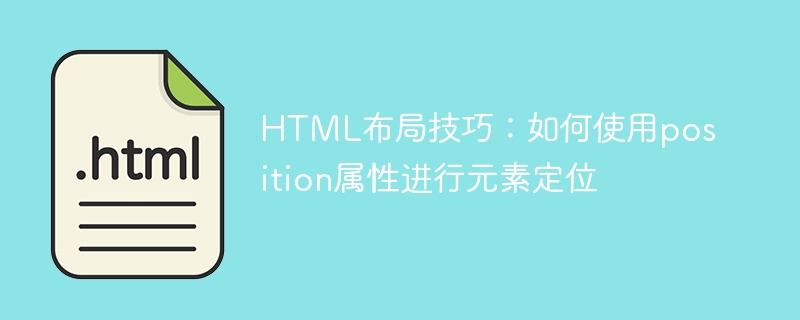

HTML layout skills: How to use the position attribute to position elements
In the process of web design and layout, we often need to position elements to achieve different layouts Effect. Among them, the position attribute is a key attribute in CSS, which can be used to specify the positioning method, position and relationship of elements relative to other elements. This article will introduce how to use the position attribute to position elements and provide specific code examples.
The position attribute has four values: static, relative, fixed and absolute.
The following is a sample code:
<style>
.box {
position: relative;
width: 200px;
height: 200px;
background-color: red;
margin: 20px;
}
.box2 {
position: relative;
top: 50px;
left: 50px;
background-color: blue;
width: 100px;
height: 100px;
}
</style>
<div class="box">
<div class="box2"></div>
</div>In this example, we create a div element with class box and set the width, height and background color. Then, we created a div element with class box2 inside the box and offset it 50 pixels down and to the right within the box by setting the top and left attributes. After running the code, you can see that box2 is positioned relative to box.
The following is a sample code:
<style>
.box {
position: fixed;
top: 50px;
right: 50px;
width: 200px;
height: 200px;
background-color: red;
}
</style>
<div class="box"></div>In this example, we create a div element with class box and position it in the upper right corner of the browser window, 50 pixels from both the top and right edges of the window. No matter the user scrolls the page, the div element always remains in a fixed position.
The following is a sample code:
<style>
.box {
position: relative;
width: 200px;
height: 200px;
background-color: red;
margin: 20px;
}
.box2 {
position: absolute;
top: 50px;
left: 50px;
background-color: blue;
width: 100px;
height: 100px;
}
</style>
<div class="box">
<div class="box2"></div>
</div>In this example, we create a div element with class box and set the width, height and background color. Then, we create a div element with class box2 inside the box and position it relative to the box. The top and left properties of box2 are set to 50 pixels respectively, which causes box2 to be offset 50 pixels downward and to the right relative to the box.
Through the flexible use of the position attribute, we can easily achieve various web page layout effects. Whether it is a fixed navigation bar, centered element or suspended element, it can be achieved by adjusting the position attribute and offset value. I hope this article can help you better master the skills of using the position attribute to position elements.
The above is the detailed content of HTML layout tips: How to use the position attribute for element positioning. For more information, please follow other related articles on the PHP Chinese website!